Drivers of Milk Production Decisions on Polish Family Farms: A Classification Tree Approach
Abstract
1. Introduction
2. Theoretical Background
2.1. Research Gap and Conceptual Justification
2.2. Resource-Based View and Complementary Perspectives (RBV, IBV, MBV)
2.3. Dynamic Capabilities and Farm Adaptability
2.4. Conceptual Framework for Farm Development Analysis
3. Data Sources and Methods
3.1. Source Data
3.2. Data Preparation, Modelling Approach and Variable Operationalisation
4. Results
4.1. Changes in Milk Production in Polish Dairy Farms Between 2005 and 2022 According to FADN Data
4.2. Analysis of the Results of the Survey Among Polish Dairy Farms
4.2.1. Resources and Socioeconomic Characteristics of the Surveyed Farms
4.2.2. Factors Conducive to Increasing Milk Production: Classification Tree Results
5. Discussion
5.1. Role of Personal Factors in Growth Processes
5.2. Scale of Production and Tangible Resources
5.3. Role of Dynamic Capabilities and Institutional and Market Factors
5.4. New Findings on the Synergy of Factors in Dairy Farm Development Decisions
6. Conclusions and Implications
- 1.
- Production expansion is the central mechanism for dairy farm growth and resilience. FADN data show that the average herd size on farms where cows were kept in 2005–2022 grew from 15.5 to 22.7 heads, which confirms production expansion. Farms that expanded their operations increased their land and capital resources simultaneously, achieving better performance and economic results. The survey results are consistent with this finding because farms with a greater potential more often declared growth-oriented attitudes. Production expansion therefore acts as a catalyst for investment and contributes to the continuation of farming operations.
- 2.
- The pivotal factor differentiating between strategies of dairy farms is the owner’s self-assessment of health and work ability. The outcomes demonstrate that it is the perceived capacity to continue farming in the coming years rather than the chronological age that influences farmers’ choices the most. Farmers who declared physical and mental fitness readiness to work in the coming five years more often planned investments and production expansion. The availability of a successor further strengthened this orientation by ensuring continuity and increasing the probability of farm survival beyond the current owner.
- 3.
- Tangible resources, especially land and herd size, form another critical area. Access to agricultural land determines the potential to expand production, while lease rent significantly affects strategic choices. The results confirm that land, herd and equipment are decisive for investment and the persistence of dairy farms. The land lease market is of particular importance because both availability and cost strongly influence expansion prospects.
- 4.
- Growth is also enhanced through economies of scale, which operate in a feedback loop with farm income. Larger herd size improves work performance at lower unit costs and leads to competitive advantage. This improves financial standing and facilitates saving and investment. A reinforcing mechanism is thus created in which a greater scale of production and stronger financial capacity mutually support each other.
- 5.
- Directions of change in dairy farms are not determined by a single factor. The ability to combine tangible, human and financial resources with external constraints is decisive. Farmers’ adaptability emerges as the key, since it enables them to respond to changing environments and adjust their growth strategies. This adaptability determines whether resources are mobilised in a way that secures persistence and competitive advantage.
- Integrating farmers’ health into agricultural policy. The physical and mental condition of farmers should be recognised as a key determinant of farm development. Public support could include preventive health programmes, occupational health monitoring and easier access to physiotherapy and psychological assistance adapted to the specific working conditions in agriculture.
- Reducing the physical burden of dairy production. Investments in mechanisation and partial automation, such as milking robots, feeding systems and herd-monitoring technologies, can substantially reduce the physical strain of work, allowing farmers to remain active longer and improving their overall well-being.
- Facilitating land access and stabilising the lease market. Transparent and flexible lease mechanisms, long-term contracts and incentives for land consolidation can enhance the development potential of viable farms while preventing excessive concentration of land.
- Improving access to capital and income stability. Expanding financial instruments that support investment, liquidity and risk management, such as preferential loans and insurance against price or yield fluctuations, would enable farmers to pursue growth-oriented strategies and increase financial resilience.
- Enhancing advisory and managerial support. Agricultural advisory services should not be limited to technical issues but should also cover business planning, financial management and strategic decision-making, thereby strengthening the adaptive capacities of dairy farms.
- Supporting intergenerational succession. Initiatives that facilitate farm transfer, including training programmes, tax incentives and mentoring schemes, can improve continuity, reduce uncertainty and maintain the long-term production potential of the dairy sector.
7. Research Limitations and Future Focus
Supplementary Materials
Author Contributions
Funding
Institutional Review Board Statement
Data Availability Statement
Conflicts of Interest
Abbreviations
| FADN | The Farm Accountancy Data Network |
| EU | European Union |
| EUR | Euro |
| SO | Standard output |
| RBV | Resource-based view |
| IBV | Institution-based view |
| MBV | Market-based view |
| CART | Classification and Regression Trees |
| ROC | Receiver operating characteristic |
| AUC | Area under curve |
| AWU | Annual work unit |
| GUS | Statistics Poland |
| DC | Dynamic Capabilities |
References
- Statistics Poland. Statistical Yearbook of Agriculture 2024; Statistics Poland: Warsaw, Poland, 2024. [Google Scholar]
- Szajner, P. (Ed.) Rynek Mleka. Stan i Perspektywy. Nr 67. Analizy Rynkowe; IERiGŻ PIB: Warsaw, Poland, 2024. [Google Scholar]
- Parzonko, A.; Bórawski, P. Pozycja Konkurencyjna Polskich Gospodarstw Mlecznych w UE-Stan, Uwarunkowania i Przewidywania Na Przyszłość; Szkoła Główna Gospodarstwa Wiejskiego w Warszawie (SGGW): Warszawa, Poland, 2021. [Google Scholar]
- Ziętara, W.; Adamski, M. Competitiveness of the polish dairy farms at the background of farms from selected european union countries. Probl. Agric. Econ. 2018, 354, 56–79. [Google Scholar] [CrossRef]
- Ziętara, W.; Pietrzak, M.; Malak-Rawlikowska, A. Polish Dairy Farm Transformations and Competitiveness 20 Years after Poland’s Accession to the European Union. Animals 2024, 14, 2013. [Google Scholar] [CrossRef]
- Bukraba-Rylska, I. Socjologia Wsi Polskiej; Wydawnictwo Naukowe PWN: Warszawa, Poland, 2008. [Google Scholar]
- Hryszko, K.; Pieniążek, K.; Rembeza, J.; Seremak-Bulge, J.; Szajner, P.; Świetlik, K. Rozwój Rynku Mleczarskiego i Zmiany Jego Funkcjonowania w Latach 1990–2005; Instytut Ekonomiki Rolnictwa i Gospodarki Żywnościowej-Państwowy Instytut Badawczy: Warszawa, Poland, 2005; Available online: https://open.icm.edu.pl/handle/123456789/4775 (accessed on 26 October 2025).
- Bórawski, P.; Pawlewicz, A.; Parzonko, A.; Harper, J.K.; Holden, L. Factors Shaping Cow’s Milk Production in the EU. Sustainability 2020, 12, 420. [Google Scholar] [CrossRef]
- Jafri, S.H.; Adnan, K.M.M.; Baimbill Johnson, S.; Talukder, A.A.; Yu, M.; Osei, E. Challenges and Solutions for Small Dairy Farms in the U.S.: A Review. Agriculture 2024, 14, 2369. [Google Scholar] [CrossRef]
- Poczta, W.; Średzińska, J.; Chenczke, M. Economic Situation of Dairy Farms in Identified Clusters of European Union Countries. Agriculture 2020, 10, 92. [Google Scholar] [CrossRef]
- Tomczak, F. Od Rolnictwa Do Agrobiznesu: Transformacja Gospodarki Rolniczo-Żywnościowej Stanów Zjednoczonych Ameryki Północnej; Szkoła Główna Handlowa-Oficyna Wydawnicza: Warszawa, Poland, 2004. [Google Scholar]
- Kusz, D. Level of Investment Expenditure versus Changes in Technical Labour Equipment and Labour Efficiency in Agriculture in Poland. In Proceedings of the International Scientific Conference Economic Sciences for Agribusiness and Rural Economy, Warsaw, Poland, 7–8 June 2018; Available online: https://js.wne.sggw.pl/index.php/esare/article/view/1477 (accessed on 26 October 2025).
- Gastaldi, L.B.; Galetto, A.J.; Pace Guerrero, I.R. Factors Affecting Exit Intentions from Dairy Farming in the Pampas Region of Argentina. Econ. Agrar. Recur. Nat. 2023, 23, 91–116. [Google Scholar] [CrossRef]
- Zorn, A.; Zimmert, F. Structural Change in the Dairy Sector: Exit from Farming and Farm Type Change. Agric. Food Econ. 2022, 10, 7. [Google Scholar] [CrossRef]
- Hansen, B.G.; Østerås, O. Farmer Welfare and Animal Welfare- Exploring the Relationship between Farmer’s Occupational Well-Being and Stress, Farm Expansion and Animal Welfare. Prev. Vet. Med. 2019, 170, 104741. [Google Scholar] [CrossRef]
- Holmes, G.; Osei, M.; Bray, J.; Discetti, R. Why Dairy Farmers Leave the Industry: The Role of Control, Autonomy, and Self-Efficacy. J. Rural Stud. 2025, 116, 103600. [Google Scholar] [CrossRef]
- Herrera Sabillón, B.; Gerster-Bentaya, M.; Knierim, A. Measuring Farmers’ Well-being: Influence of Farm-level Factors on Satisfaction with Work and Quality of Life. J. Agric. Econ. 2022, 73, 452–471. [Google Scholar] [CrossRef]
- Teece, D.J.; Pisano, G.; Shuen, A. Dynamic capabilities and strategic management. Strateg. Manag. J. 1997, 18, 509–533. [Google Scholar] [CrossRef]
- Hansson, H.; Ferguson, R.; Olofsson, C. Psychological Constructs Underlying Farmers’ Decisions to Diversify or Specialise Their Businesses—An Application of Theory of Planned Behaviour. J. Agric. Econ. 2012, 63, 465–482. [Google Scholar] [CrossRef]
- Rodriguez-Lizano, V.A.; Montero-Vega, M.; Sibelet, N. Which Variables Influence the Succession Process in Family Farms? A Literature Review. Cah. Agric. 2020, 29, 39. [Google Scholar] [CrossRef]
- Chamberlin, E. The Theory of Monopolistic Competition; Harvard University: Cambridge, MA, USA, 1933. [Google Scholar]
- Wernerfelt, B. A Resource-based View of the Firm. Strateg. Manag. J. 1984, 5, 171–180. [Google Scholar] [CrossRef]
- Barney, J. Firm Resources and Sustained Competitive Advantage. J. Manag. 1991, 17, 99–120. [Google Scholar] [CrossRef]
- Itami, H.; Roehl, T. Mobilizing Invisible Assets; Harvard University Press: Cambridge, MA, USA, 1991. [Google Scholar]
- Romanowska, M. Kształtowanie Wartości Firmy w Oparciu o Kapitał Intelektualny. In Systemy Informacji Strategicznej. Wywiad Gospodarczy a Konkurencyjność Przedsiębiorstwa; Borowiecki, R., Romanowska, M., Eds.; Difin: Warszawa, Poland, 2001. [Google Scholar]
- Parzonko, A.; Bórawski, P. Competitiveness of Polish Dairy Farms in the European Union. Agric. Econ. 2020, 66, 168–174. [Google Scholar] [CrossRef]
- Oliver, C. Sustainable competitive advantage: Combining institutional and resource-based views. Strateg. Manag. J. 1997, 18, 697–713. [Google Scholar] [CrossRef]
- Peng, M.W.; Sun, S.L.; Pinkham, B.; Chen, H. The institution-based view as a third leg for a strategy tripod. Acad. Manag. Perspect. 2009, 23, 63–81. [Google Scholar] [CrossRef]
- Amgai, S.; Komarek, A.M.; Adhikari, R.P. Understanding the role of policy in enhancing agrifood value chain competitiveness: A systematic literature review. J. Agric. Food Res. 2025, 22, 102022. [Google Scholar] [CrossRef]
- Peng, M.W. Towards an institution-based view of business strategy. Asia Pac. J. Manag. 2002, 19, 251–267. [Google Scholar] [CrossRef]
- Porter, M.E. Competitive Strategy: Techniques for Analyzing Industries and Competitors; Free Press: New York, NY, USA, 1980. [Google Scholar]
- Vigfússon, K.; Johannsdottir, L.; Olafsson, S.; Köseoglu, M.A. Integrating resource-based and market-based views in the fisheries industry–CEO perspectives. Mar. Policy 2025, 171, 106454. [Google Scholar] [CrossRef]
- Teece, D.J. Explicating dynamic capabilities: The nature and microfoundations of (sustainable) enterprise performance. Strateg. Manag. J. 2007, 28, 1319–1350. [Google Scholar] [CrossRef]
- Thorsøe, M.; Noe, E.; Maye, D.; Vigani, M.; Kirwan, J.; Chiswell, H.; Grivins, M.; Adamsone-Fiskovica, A.; Tisenkopfs, T.; Tsakalou, E.; et al. Responding to change: Farming system resilience in a liberalized and volatile European dairy market. Land Use Policy 2020, 99, 105029. [Google Scholar] [CrossRef]
- Bastanchury-López, M.T.; De-Pablos-Heredero, C.; Montes-Botella, J.L.; Martín-Romo-Romero, S.; García, A. Impact of Dynamic Capabilities on Performance in Dairy Sheep Farms in Spain. Sustainability 2020, 12, 3368. [Google Scholar] [CrossRef]
- Breiman, L.; Ihaka, R. Nonlinear Discriminant Analysis via Scaling and ACE; Technical Report; Department of Statistics, University of California: Davis, CA, USA, 1984. [Google Scholar]
- Maimon, O.; Rokach, L. Decomposition methodology for knowledge discovery and data mining. In Data Mining and Knowledge Discovery Handbook; Maimon, O., Rokach, L., Eds.; Springer: Boston, MA, USA, 2005; pp. 981–1003. [Google Scholar] [CrossRef]
- Sroka, W.; Król, K.; Kulesza, J.; Stanuch, M.; Lisek, S. Community Readiness for Agro Living Lab (ALL) Projects: Factors Influencing Engagement of Young Urban Residents. Agriculture 2025, 15, 94. [Google Scholar] [CrossRef]
- Machuca, C.; Vettore, M.V.; Krasuska, M.; Baker, S.R.; Robinson, P.G. Using classification and regression tree modelling to investigate response shift patterns in dentine hypersensitivity. BMC Med. Res. Methodol. 2017, 17, 120. [Google Scholar] [CrossRef] [PubMed]
- Parzonko, A.; Wojewodzic, T.; Czekaj, M.; Płonka, R.; Parzonko, A.J. Remuneration for Own Labour in Family-Run Dairy Farms Versus the Salaries and Wages in Non-Agricultural Sectors of the Economy—Evaluation of the Situation in Poland in 2005–2022. Agriculture 2025, 15, 1314. [Google Scholar] [CrossRef]
- Zhang, G.; Gionis, A. Regularized Impurity Reduction: Accurate Decision Trees with Complexity Guarantees. Data Min. Knowl. Discov. 2023, 37, 434–475. [Google Scholar] [CrossRef]
- Pawlak, K.; Poczta, W. Competitiveness of Polish Agriculture in the Context of Globalization and Economic Integration Competitive Potential and Position. Probl. Agric. Econ. 2020, 4, 86–107. [Google Scholar] [CrossRef]
- Ziętara, W.; Adamski, M. Skala Produkcji, Efektywność i Konkurencyjność Polskich Gospodarstw Wyspecjalizowanych w Produkcji Mleka. Zagadnienia Ekon. Rolnej 2014, 1, 97–115. Available online: https://open.icm.edu.pl/handle/123456789/6343 (accessed on 26 October 2025).
- Wilczyński, A.; Kołoszycz, E. Economic Resilience of EU Dairy Farms: An Evaluation of Economic Viability. Agriculture 2021, 11, 510. [Google Scholar] [CrossRef]
- Fałkowski, J.; Malak-Rawlikowska, A.; Milczarek-Andrzejewska, D. Farmers’ Self-Reported Bargaining Power and Price Heterogeneity. Br. Food J. 2017, 119, 1672–1686. [Google Scholar] [CrossRef]
- Sumner, D.A.; Leiby, J.D. An Econometric Analysis of the Effects of Human Capital on Size and Growth among Dairy Farms. Am. J. Agric. Econ. 1987, 69, 465–470. [Google Scholar] [CrossRef]
- Hamilton, W.; Bosworth, G.; Ruto, E. Entrepreneurial Younger Farmers and the” Young Farmer Problem” in England. Agric. For. 2015, 61, 61–69. [Google Scholar] [CrossRef]
- Olsen, J.V.; Lund, M. The Impact of Socio-Economic Factors and Incentives on Farmers’ Investment Behaviour. Food Econ.-Acta Agric. Scand. Sect. C 2011, 8, 173–185. [Google Scholar] [CrossRef]
- Liu, Y.; Chen, M.; Yu, J.; Wang, X. Being a Happy Farmer: Technology Adoption and Subjective Well-Being. J. Econ. Behav. Organ. 2024, 221, 385–405. [Google Scholar] [CrossRef]
- Thelin, A.; Holmberg, S. Farmers and Retirement: A Longitudinal Cohort Study. J. Agromed. 2010, 15, 38–46. [Google Scholar] [CrossRef]
- Bertolozzi-Caredio, D.; Bardaji, I.; Coopmans, I.; Soriano, B.; Garrido, A. Key Steps and Dynamics of Family Farm Succession in Marginal Extensive Livestock Farming. J. Rural Stud. 2020, 76, 131–141. [Google Scholar] [CrossRef]
- Coopmans, I.; Dessein, J.; Accatino, F.; Antonioli, F.; Bertolozzi-Caredio, D.; Gavrilescu, C.; Gradziuk, P.; Manevska-Tasevska, G.; Meuwissen, M.; Peneva, M.; et al. Understanding farm generational renewal and its influencing factors in Europe. J. Rural Stud. 2021, 86, 398–409. [Google Scholar] [CrossRef]
- Bertolozzi Caredio, D. The Farm Succession Effect on Farmers’ Management Choices. Land Use Policy 2024, 137, 107014. [Google Scholar] [CrossRef]
- Ivanova, I.; Trotsenko, I.; Trotsenko, V. Automation of Processes in Dairy Cattle Production. IOP Conf. Ser. Mater. Sci. Eng. 2019, 582, 012035. [Google Scholar] [CrossRef]
- Shortall, J.; Shalloo, L.; Foley, C.; Sleator, R.D.; O’Brien, B. Investment Appraisal of Automatic Milking and Conventional Milking Technologies in a Pasture-Based Dairy System. J. Dairy Sci. 2016, 99, 7700–7713. [Google Scholar] [CrossRef]
- Lavrijsen-Kromwijk, L.; Demba, S.; Müller, U.; Rose, S. Impact of Automation Level of Dairy Farms in Northern and Central Germany on Dairy Cattle Welfare. Animals 2024, 14, 3699. [Google Scholar] [CrossRef] [PubMed]
- Ben Hassen, T.; El Bilali, H.; Daher, B.; Burkart, S. Sustainable and resilient food systems in times of crises. Front. Nutr. 2025, 12, 1564950. [Google Scholar] [CrossRef] [PubMed]
- Latruffe, L.; Piet, L. Does land fragmentation affect farm performance? A case study from Brittany, France. Agric. Syst. 2014, 129, 68–80. [Google Scholar] [CrossRef]
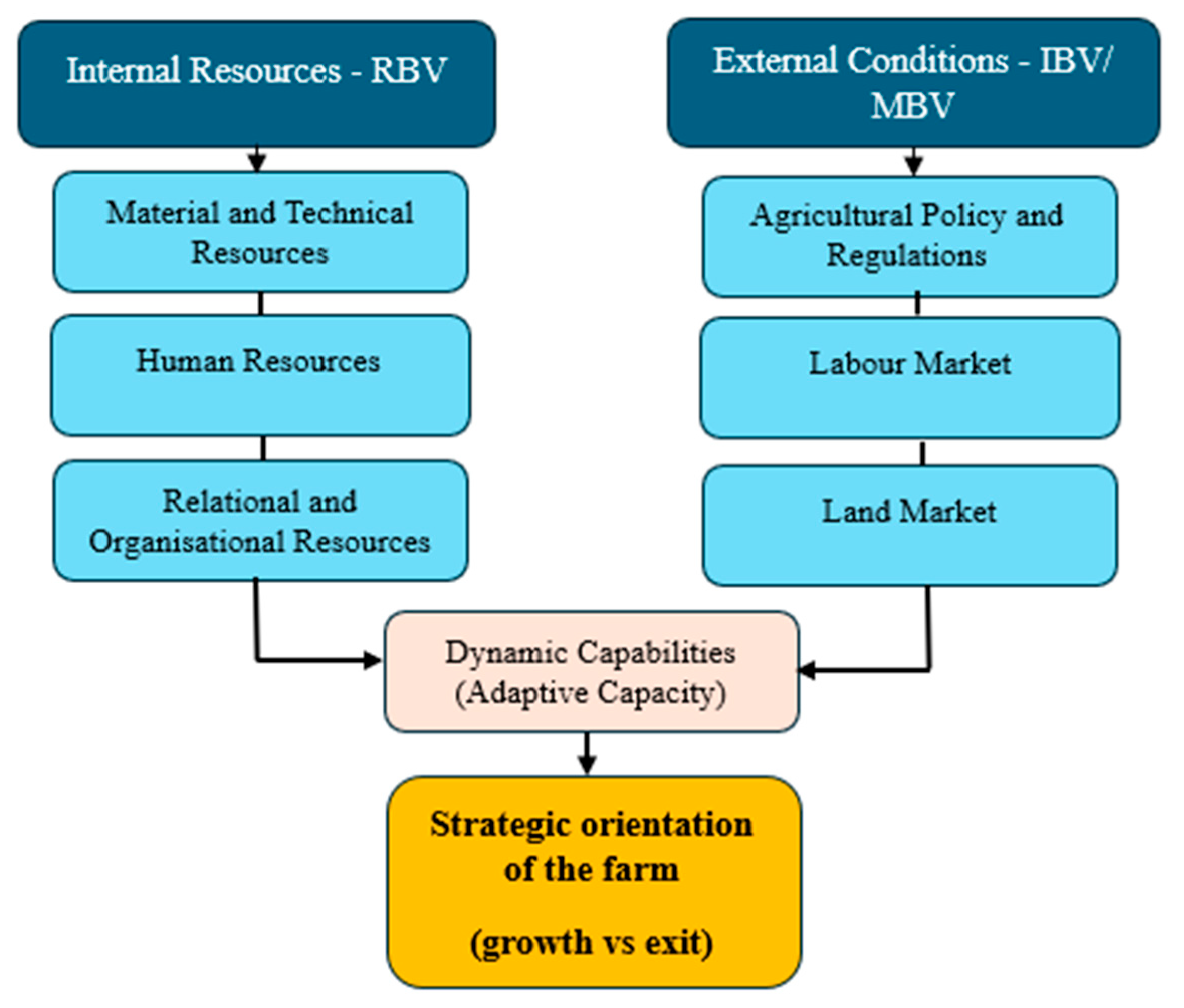
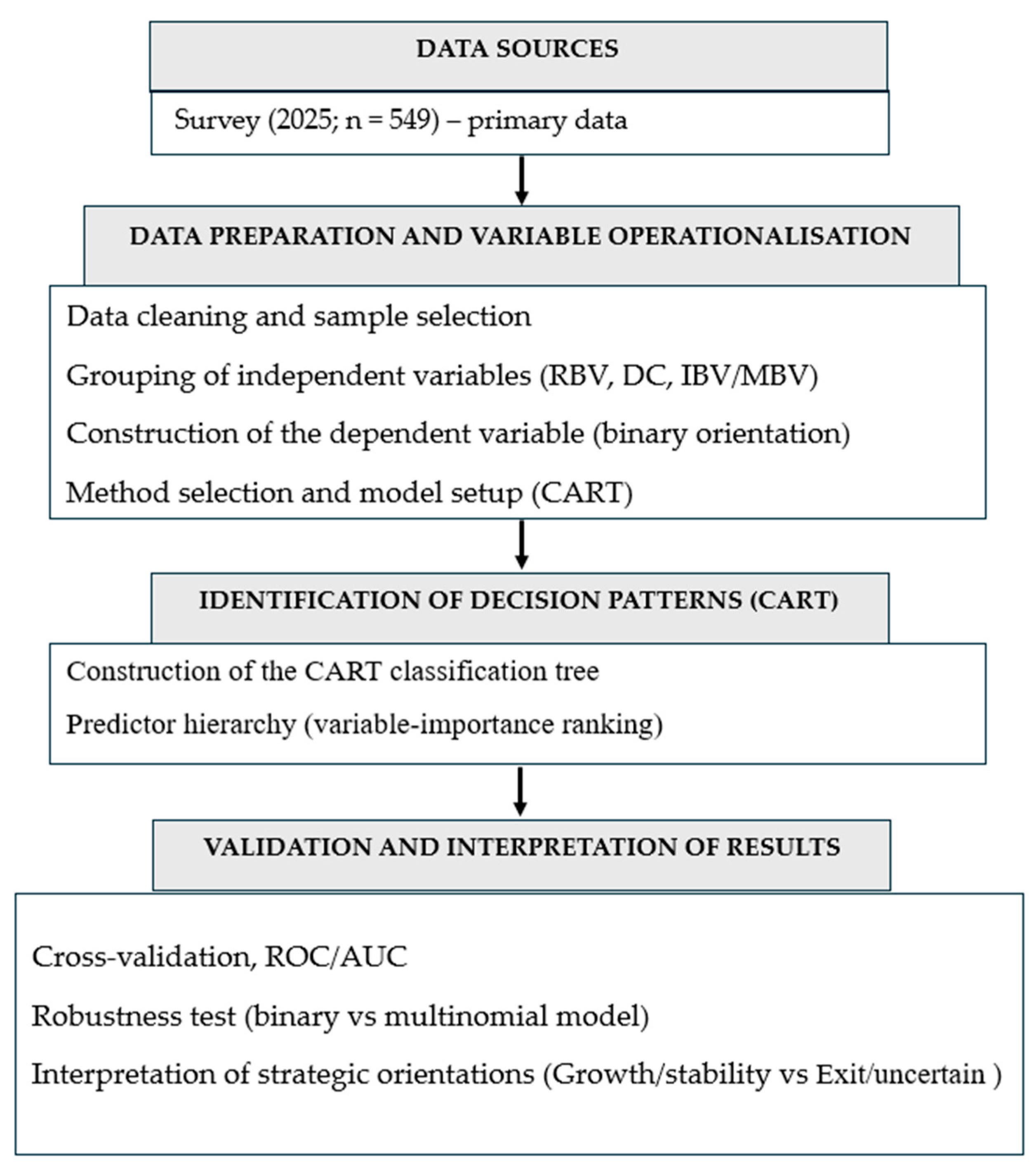


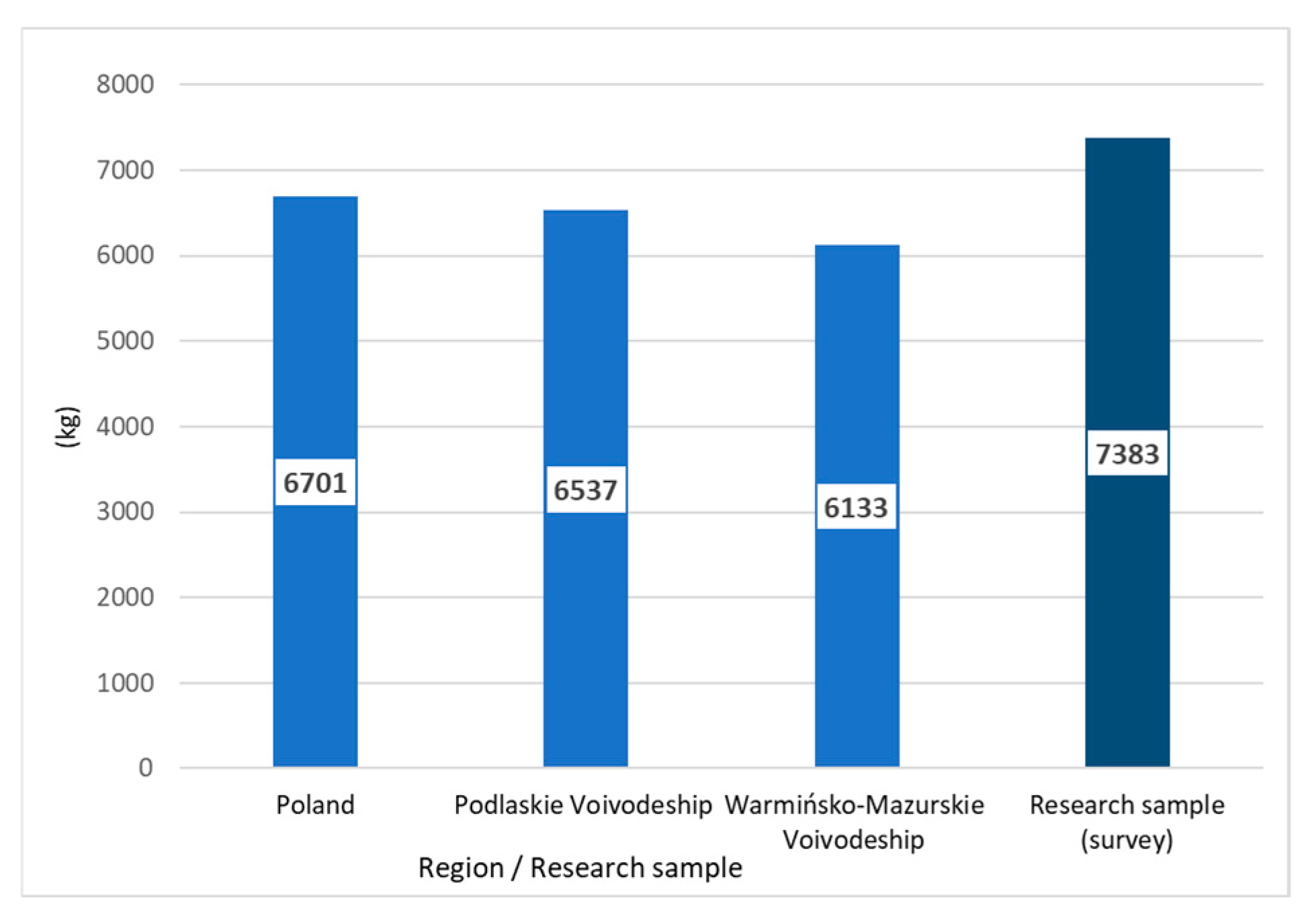
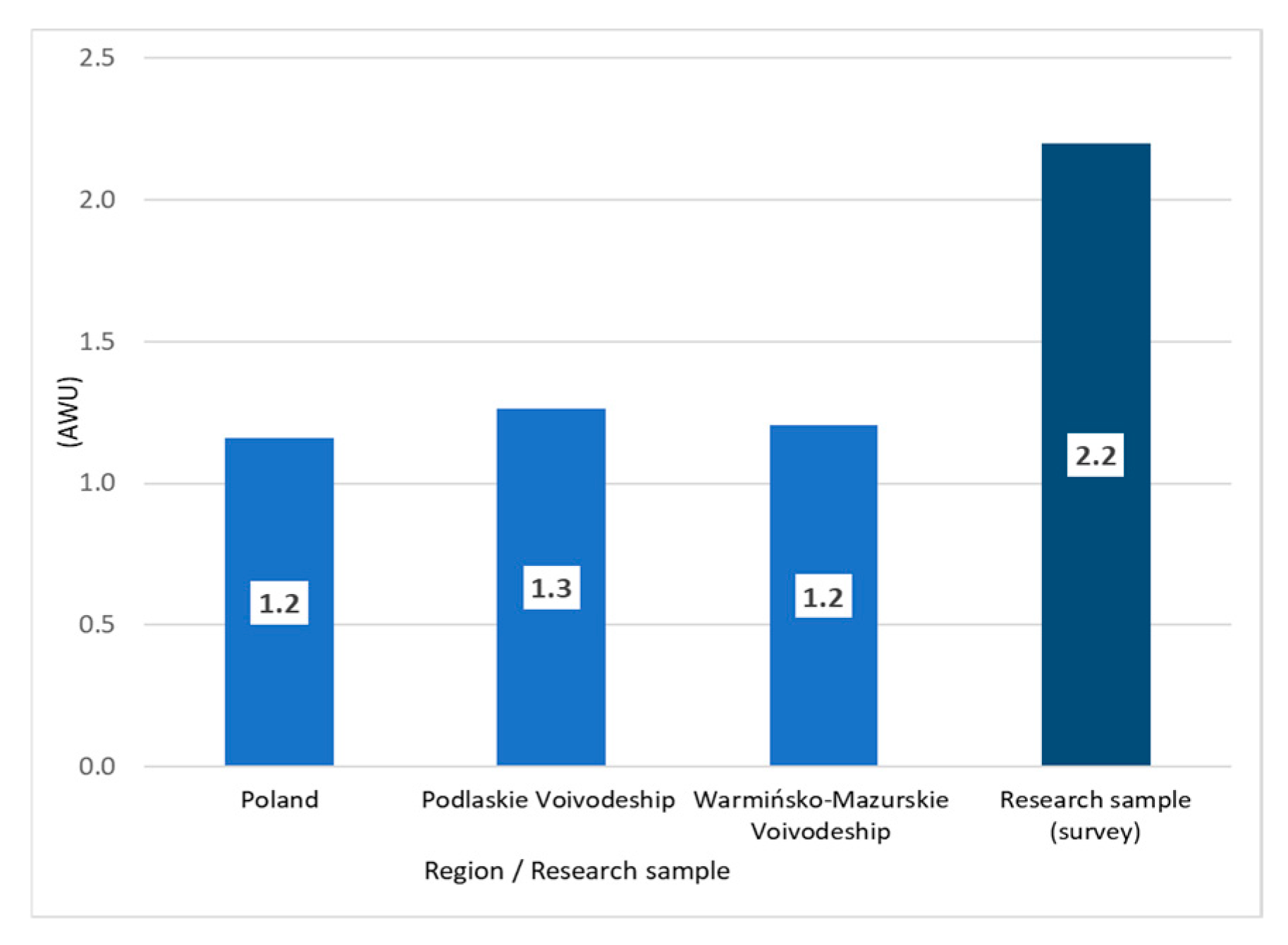
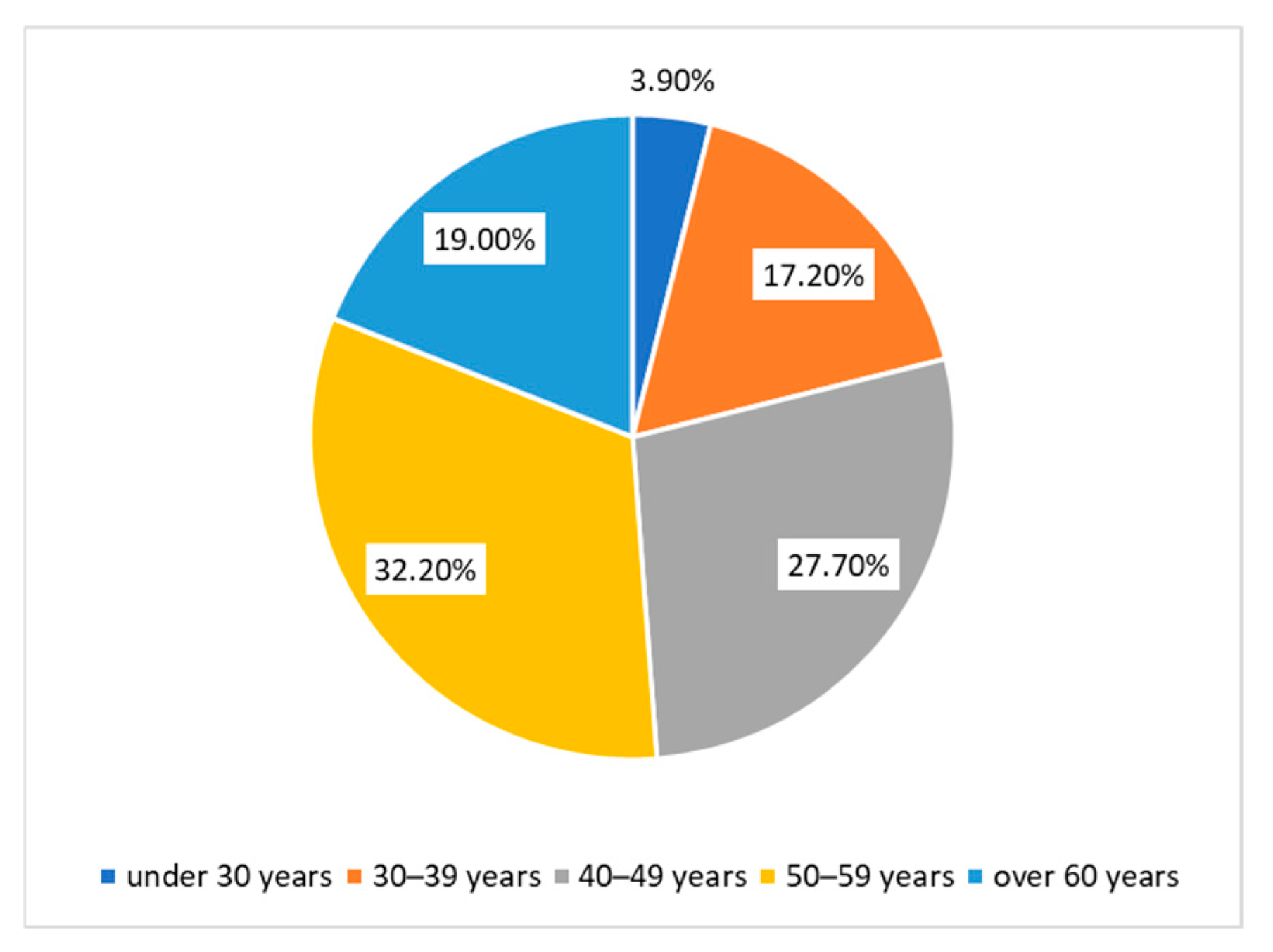
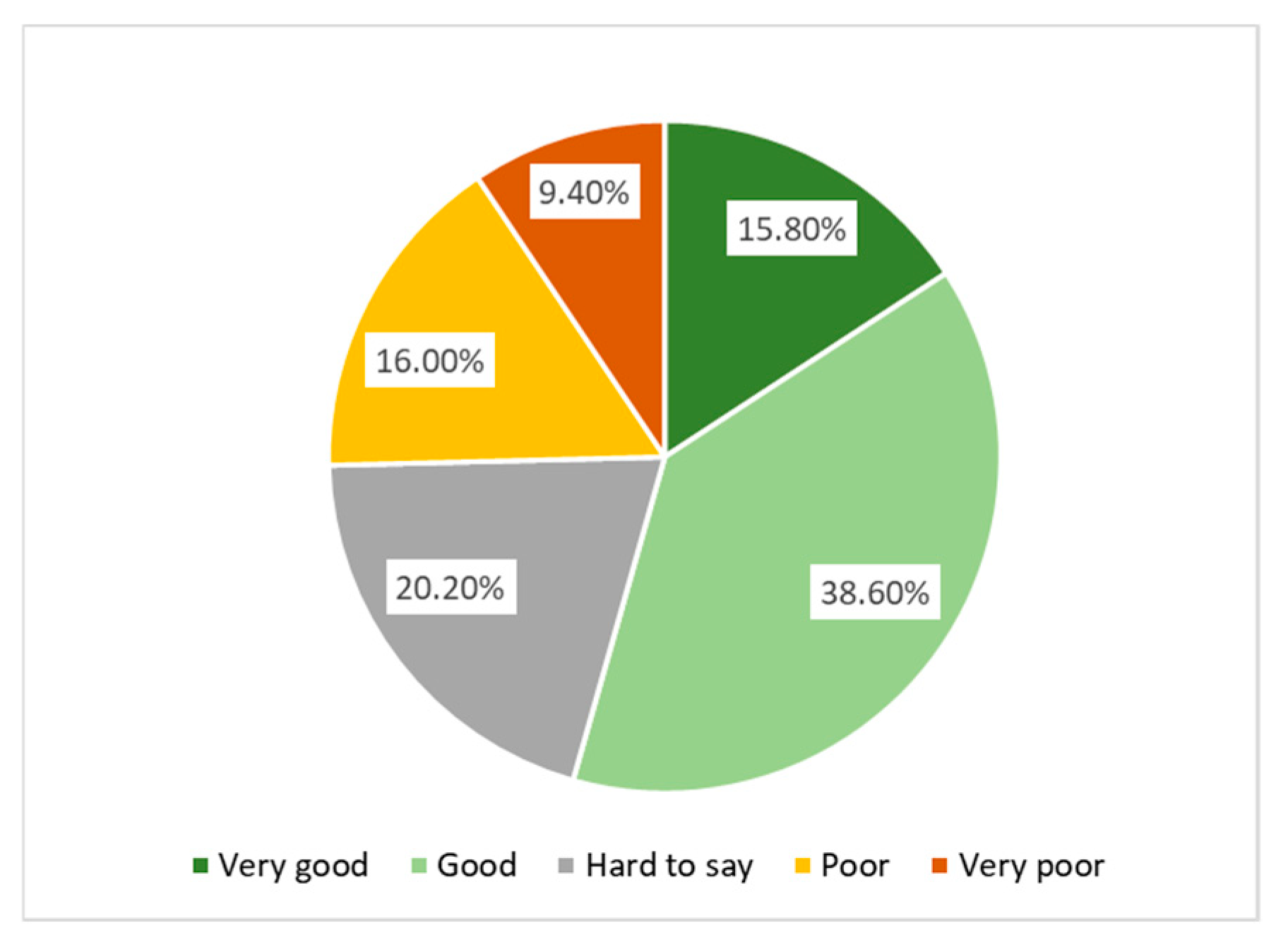
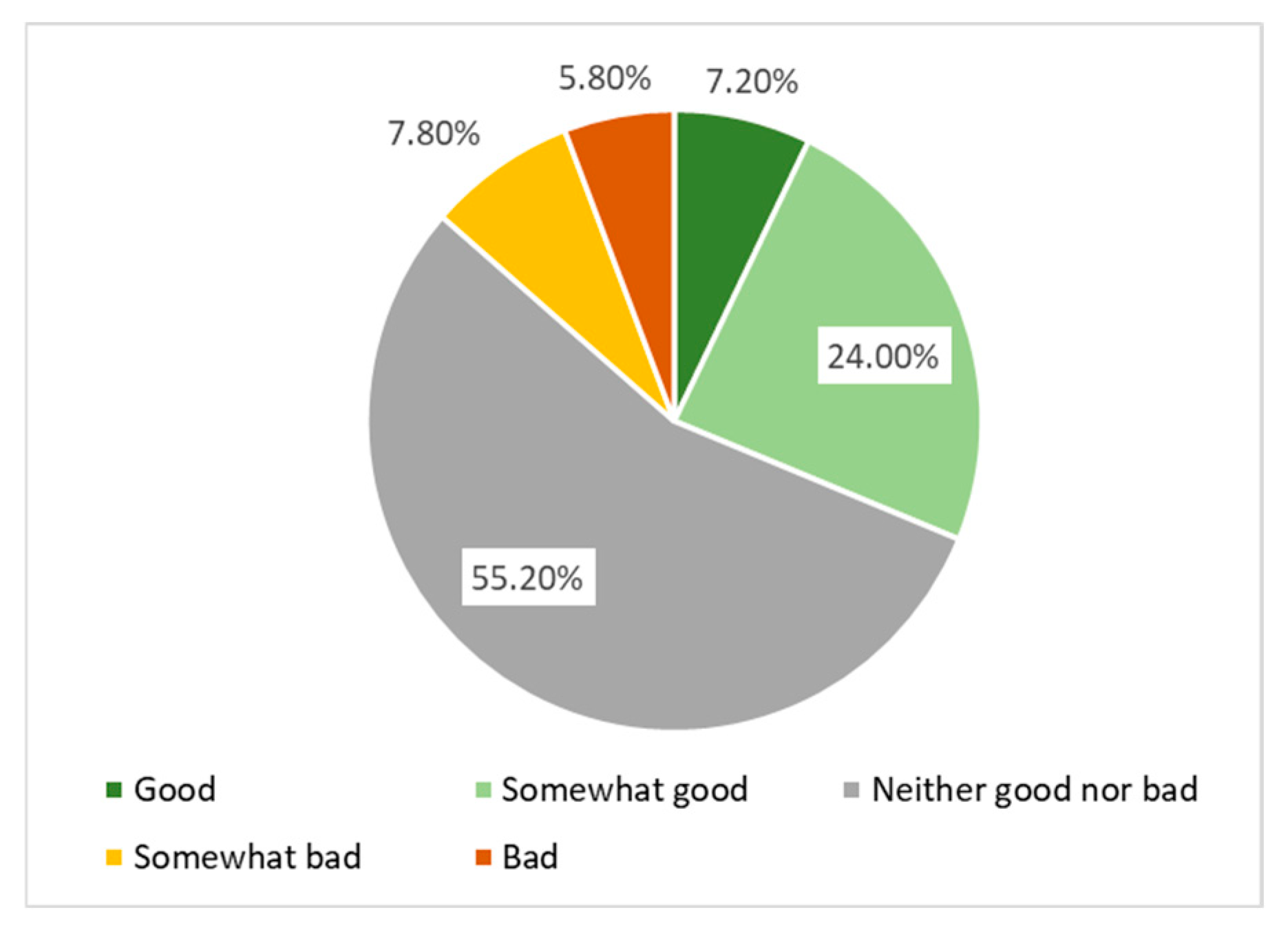
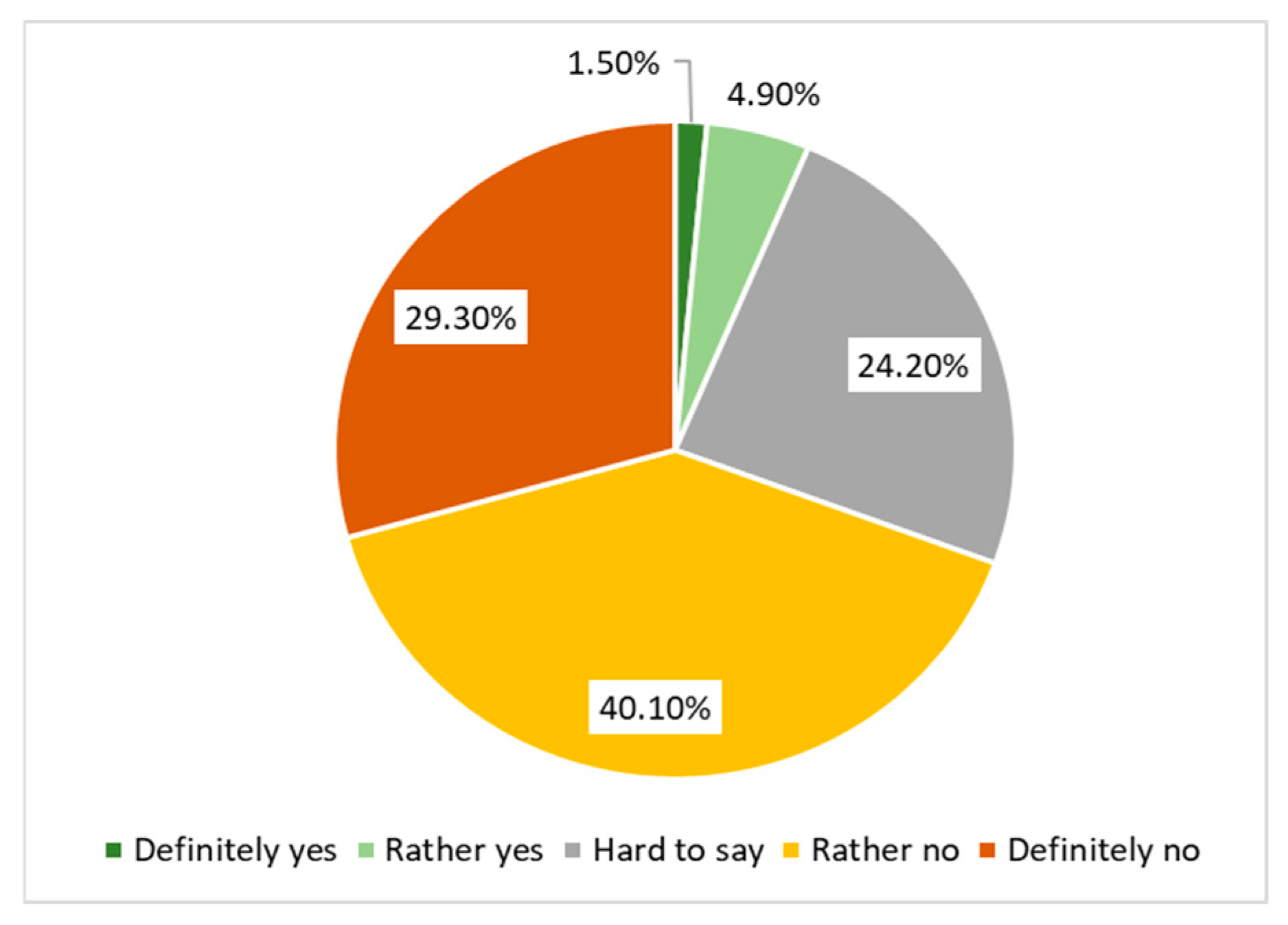

| Factor/Area | Presence in the Literature | Typical Research Approach | Identified Research Gap |
|---|---|---|---|
| Production scale (herd size, land area, investments) | Very frequently studied (e.g., [4,10]) | Regressions, logit models, correlations, synthetic indicators | Lack of connection with personal and adaptive factors |
| Demographic factors (farmer’s age, succession, education) | Frequently studied (e.g., [13,14]) | Logit models, SEM, panel analyses | Usually analysed separately, without interdependence analysis |
| Farmer’s health and work ability (and psychological factors) | Rarely studied (e.g., [15,16]) | Qualitative studies, reviews, occasional quantitative models | Lack of integration with economic and decision-making analyses |
| Flexibility, motivation, market perception (farmer’s attitude, readiness for change) | Appears in the context of well-being and resilience (e.g., [17]) | Surveys, SEM, regression models, case studies | No link with investment or development decisions |
| Dynamic capabilities and farm resilience (financial flexibility, adaptive, investment and organisational capacity) | Occasionally discussed (e.g., [18,19]) | Case studies, interviews, descriptive and qualitative analyses | Lack of quantitative operationalisation of flexibility and adaptive capacity in family farms |
| Institutional and market factors (agricultural policy, competition, resource availability) | Present in sectoral and comparative studies (e.g., [2,3,5,7,8]) | Descriptive, comparative, panel studies, linear regression | Lack of integration with resource and human factor analysis at the farm level |
| Variable Category | Scope | Data Type |
|---|---|---|
| Dependent variable | Declared plans for the future scale of milk production (5-year horizon) | Categorical (binary): growth/stability-oriented exit/uncertain-oriented |
| Independent variables | ||
| RBV: tangible and technical resources | Utilised agricultural area, cow count, buildings, machines, innovations | Quantitative/binary/ordinal |
| RBV: human resources | Farmer’s perceived health and work ability (5-year horizon), age, labour, availability of successor | Quantitative/categorical |
| RBV: relational and organisational resources | Cooperation with the dairy plant, use of consulting, production system | Ordinal/binary |
| RBV: intangible resources and innovation | Use of cowshed management software | Binary |
| Dynamic Capabilities: financial standing and adaptability | Income self-assessment, potential for savings and investments, debt level, self-assessment of resilience to external changes, perceived land and labour resources | Ordinal/binary |
| IBV/MBV: market and institutional environment | Land availability, lease rent, hired labour availability, agricultural and commercial policy (such as cereal imports from Ukraine), media discourse on cattle environmental impact | Ordinal/categorical |
| Average Dairy Cow Herd Size by Farm Group | Number of Farms in a Group | Total Agricultural Land (ha) | Total Labour Inputs (Hours per Year) | |||
|---|---|---|---|---|---|---|
| A | B | A | B | A | B | |
| Farms reducing herd counts | ||||||
| 10.01–20.00 | 3.00–10.00 | 24 | 20.1 | 23.2 | 4500 | 3764 |
| Farms increasing herd counts | ||||||
| 3.00–10.00 | 10.01–20.00 | 61 | 20.2 | 28.6 | 3993 | 4215 |
| 10.01–20.00 | 20.01–30.00 | 72 | 26.7 | 35.5 | 4381 | 4866 |
| 10.01–20.00 | 30.01–50.00 | 36 | 31.4 | 48.2 | 4504 | 4821 |
| 20.01–30.00 | 30.01–50.00 | 39 | 34.7 | 46.3 | 4419 | 5488 |
| 30.01–50.00 | >50.00 | 23 | 54.0 | 77.2 | 5372 | 6819 |
| Farms with unchanged herd counts | ||||||
| 3.00–10.00 | 3.00–10.00 | 86 | 18.6 | 22.4 | 4161 | 4025 |
| 10.01–20.00 | 10.01–20.00 | 63 | 22.9 | 29.1 | 4245 | 4411 |
| 20.01–30.00 | 20.01–30.00 | 25 | 35.5 | 48.4 | 4520 | 5100 |
| 30.01–50.00 | 30.01–50.00 | 15 | 49.7 | 73.4 | 5077 | 5900 |
| Average Dairy Cow Herd Size by Farm Group | Owned Farming Assets, Excl. Land (Thousand EUR) | Family Farm Income (Thousand EUR) | |||
|---|---|---|---|---|---|
| A | B | A (1) | B (2) | A (1) | B (2) |
| Farms reducing herd counts | |||||
| 10.01–20.00 | 3.00–10.00 | 78.8 | 74.4 | 11.7 | 19.2 |
| Farms increasing herd counts | |||||
| 3.00–10.00 | 10.01–20.00 | 65.7 | 107.6 | 9.2 | 30.8 |
| 10.01–20.00 | 20.01–30.00 | 85.9 | 150.9 | 14.7 | 48.3 |
| 10.01–20.00 | 30.01–50.00 | 89.2 | 225.6 | 15.9 | 71.1 |
| 20.01–30.00 | 30.01–50.00 | 121.8 | 244.8 | 22.3 | 71.1 |
| 30.01–50.00 | >50.00 | 190.0 | 446.1 | 45.7 | 151.1 |
| Farms with unchanged herd counts | |||||
| 3.00–10.00 | 3.00–10.00 | 59.5 | 64.3 | 6.9 | 16.0 |
| 10.01–20.00 | 10.01–20.00 | 81.7 | 108.8 | 13.3 | 31.7 |
| 20.01–30.00 | 20.01–30.00 | 123.9 | 177.8 | 20.4 | 55.7 |
| 30.01–50.00 | 30.01–50.00 | 183.0 | 335.7 | 39.1 | 91.9 |
| Variable Name | Theoretical Model Category | Importance |
|---|---|---|
| Farmer’s perceived health and work ability (5-year horizon) | RBV: human resources | 1.000000 |
| Number of dairy cows | RBV: tangible resources | 0.812162 |
| Income self-assessment | Dynamic Capabilities: financial standing | 0.795980 |
| Declared potential to save or invest | Dynamic Capabilities: financial standing | 0.776898 |
| Milk yield per cow | RBV: tangible and performance-related resources | 0.720451 |
| Labour resources sufficient to increase production | Dynamic Capabilities: perceived resources | 0.589899 |
| Age of farm owner | RBV: human resources | 0.563556 |
| Availability of hired labour (farmer’s assessment) | IBV/MBV: labour market | 0.551414 |
| Leased agricultural land | RBV: tangible resources | 0.537901 |
| Farm machinery and equipment | RBV: tangible and technical resources | 0.474105 |
| Farm debt (self-assessment) | Dynamic Capabilities: financial standing | 0.465851 |
| Own agricultural land | RBV: tangible resources | 0.461902 |
| Land resources sufficient to increase production | Dynamic Capabilities: perceived resources | 0.441238 |
| Perceived impact of policy and media on the future of milk production | IBV/MBV: perceived environment | 0.423377 |
| Successor available | RBV: human resources | 0.410934 |
| Use of agricultural consulting | RBV: relational and organisational resources | 0.403098 |
| Satisfaction with the dairy plant | RBV: relational and organisational resources | 0.389852 |
| Local land lease rent (€/ha) | IBV/MBV: land market | 0.356069 |
| Perceived benefits of duty-free grain imports from Ukraine | IBV/MBV: trade policy | 0.339460 |
| Value of cowshed | RBV: tangible and technical resources | 0.341457 |
| Age of cowshed | RBV: tangible and technical resources | 0.301923 |
| Use of cowshed management software | RBV: intangible resources and innovation | 0.298588 |
| Number of permanent workers | RBV: human resources | 0.286786 |
| Availability of land on local market (farmer’s assessment) | IBV/MBV: land market | 0.224619 |
| Production system | RBV: organisational and production system | 0.170444 |
| Perceived impact of EU agri-environmental policy (CAP) | IBV/MBV: external factors / policy (perceived) | 0.166114 |
| Perceived resilience to external changes | Dynamic Capabilities: resilience and flexibility | 0.166114 |
| Number of seasonal/occasional workers | RBV: human resources | 0.137116 |
| Hiring workers outside family | RBV: human resources | 0.087720 |
| Metric | Value |
|---|---|
| Risk of error (training dataset) | 0.2157 |
| Standard error (training dataset) | 0.0176 |
| Risk of error, V-fold cross-validation | 0.2245 |
| Standard error, cross validation | 0.0193 |
| AUC (ROC) | 0.8404 |
| Gini coefficient | 0.6808 |
Disclaimer/Publisher’s Note: The statements, opinions and data contained in all publications are solely those of the individual author(s) and contributor(s) and not of MDPI and/or the editor(s). MDPI and/or the editor(s) disclaim responsibility for any injury to people or property resulting from any ideas, methods, instructions or products referred to in the content. |
© 2025 by the authors. Licensee MDPI, Basel, Switzerland. This article is an open access article distributed under the terms and conditions of the Creative Commons Attribution (CC BY) license (https://creativecommons.org/licenses/by/4.0/).
Share and Cite
Sroka, W.; Parzonko, A.; Wojewodzic, T.; Czekaj, M.; Luty, L.; Drab, A. Drivers of Milk Production Decisions on Polish Family Farms: A Classification Tree Approach. Agriculture 2025, 15, 2250. https://doi.org/10.3390/agriculture15212250
Sroka W, Parzonko A, Wojewodzic T, Czekaj M, Luty L, Drab A. Drivers of Milk Production Decisions on Polish Family Farms: A Classification Tree Approach. Agriculture. 2025; 15(21):2250. https://doi.org/10.3390/agriculture15212250
Chicago/Turabian StyleSroka, Wojciech, Andrzej Parzonko, Tomasz Wojewodzic, Marta Czekaj, Lidia Luty, and Adam Drab. 2025. "Drivers of Milk Production Decisions on Polish Family Farms: A Classification Tree Approach" Agriculture 15, no. 21: 2250. https://doi.org/10.3390/agriculture15212250
APA StyleSroka, W., Parzonko, A., Wojewodzic, T., Czekaj, M., Luty, L., & Drab, A. (2025). Drivers of Milk Production Decisions on Polish Family Farms: A Classification Tree Approach. Agriculture, 15(21), 2250. https://doi.org/10.3390/agriculture15212250







